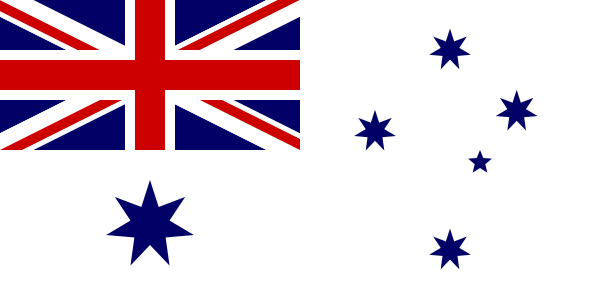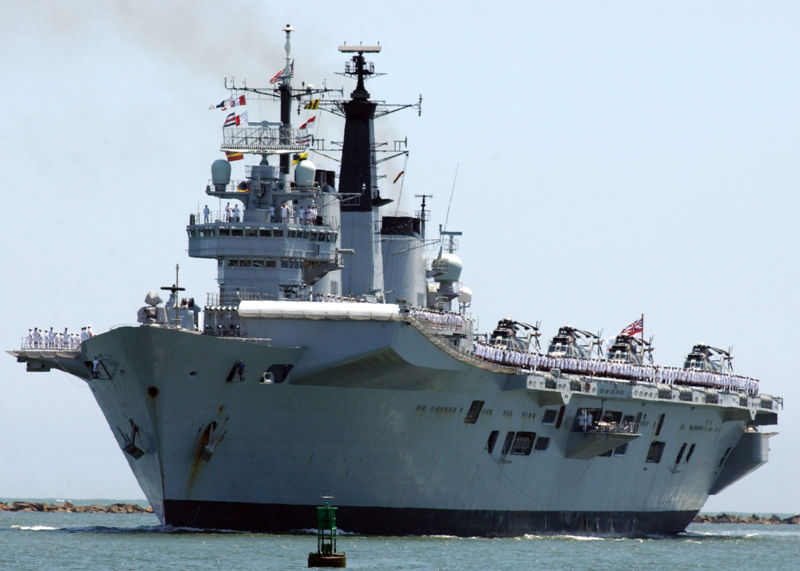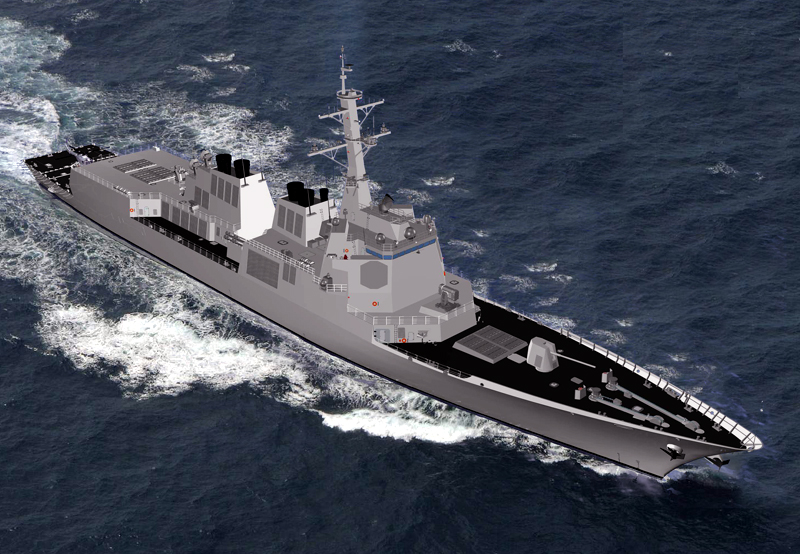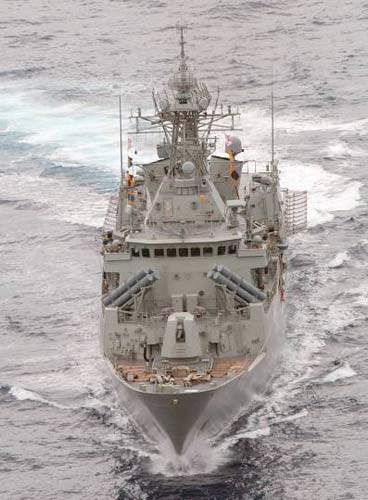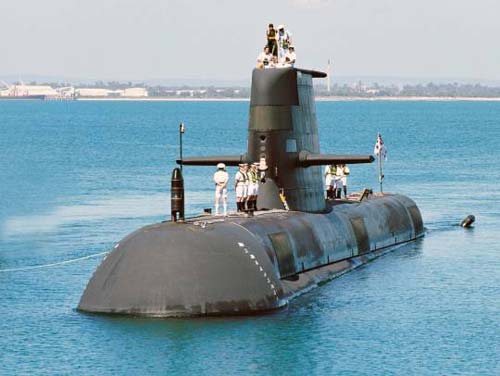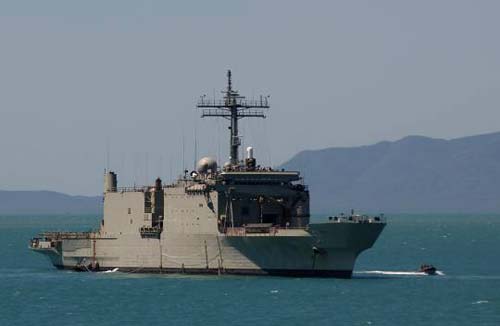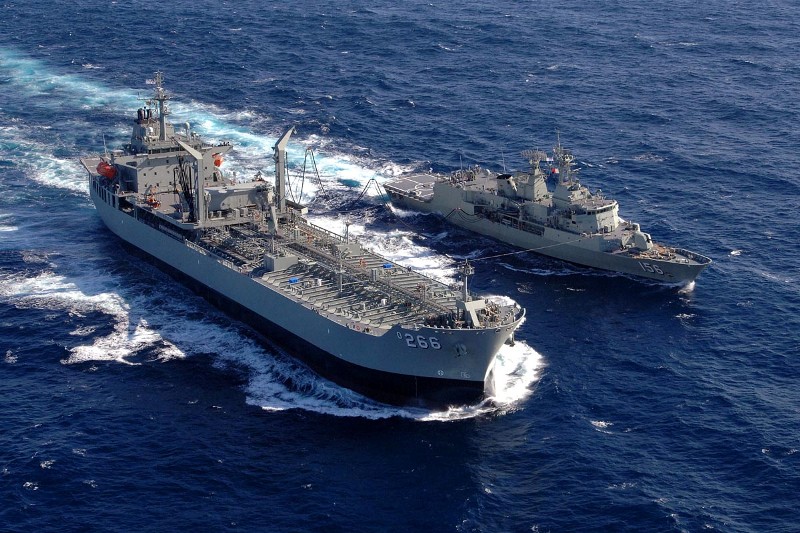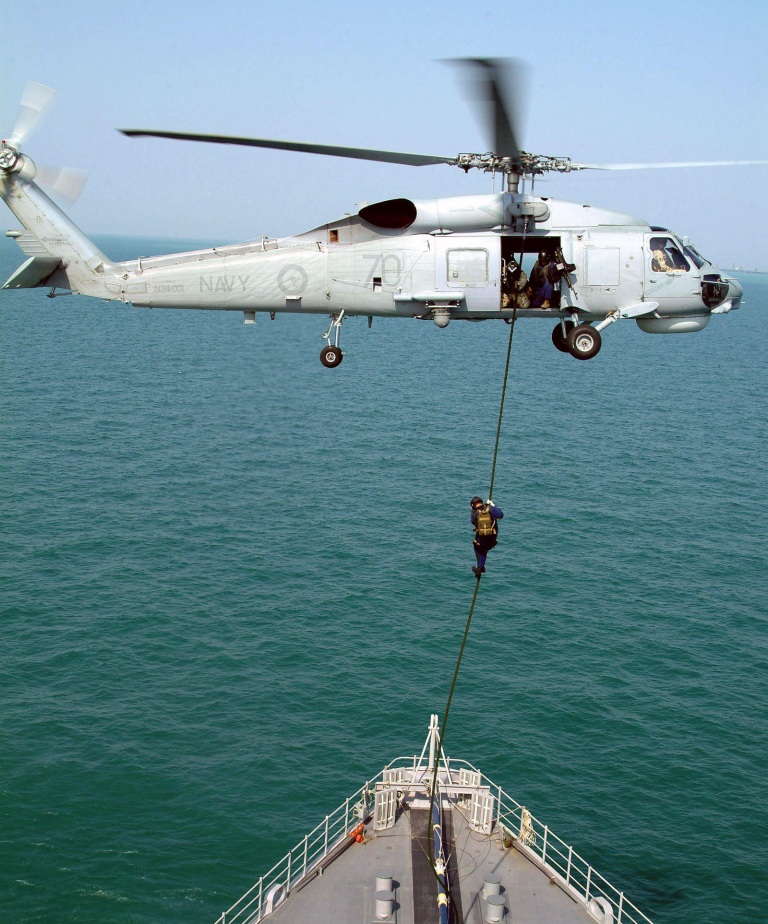Royal Australian Navy
From Daily Escape
| Royal Australian Navy | |
| | |
| The Australian White Ensign | |
| | |
| Founded | 10 July 1911 |
| Country | Australia |
| Branch | Navy |
| Part of | Australian Defence Force |
| Naval Headquarters | Canberra |
| Size | 80 ships, about 15,000 personnel |
| Commanders | |
| Chief of the Naval Staff | Vice Admiral Sir Russ Shalders, AK |
| Deputy Chief of the Naval Staff | Rear Admiral Russell Crane CSM |
| Commander Australian Fleet | Rear Admiral Sir Nigel Stephen Coates, AK |
| Insignia | |
| Navy Crest | 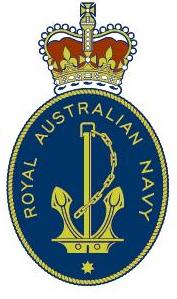
|
| Ship classes | |
| Aircraft carriers | Australia class (Invincible class) |
| Cruisers | Hobart class |
| Destroyers | Battle class |
| Frigates | ANZAC Class |
| Submarines | Collins class |
| Patrol craft | Armidale class, Pacific class |
| Amphibious ships | Canberra class, Kanimbla class, Balikpapan class |
| Auxiliaries | Success class, HMAS Sirius |
| Aircraft flown | |
| Fighter/Ground Attack | Boeing AV-8B Harrier II Plus |
| ASW Helicopter | Sikorsky S-70B-2 Sea Hawk |
| VERTREP | NH Industries NH90 |
| AEW Helicopter | Westland Sea King ASaC Mk.57 |
The Royal Australian Navy (RAN) is the naval branch of the Australian Defence Force. Established in 1911, the RAN was formed out of the Commonwealth Naval Forces to become the small navy of Australia after federation, consisting of the former colonial navies of the new Australian states. The Royal Navy of the United Kingdom continued to provide blue-water defence in the Pacific until World War II, when expansion of the RAN saw the acquisition of aircraft carriers, and other large surface vessels.
After World War II, the RAN was focussed on forward defence in South East Asia, therefore the RAN was structure to provide a carrier battle group to a NATO, or SEATO command. This was centred around the carrier HMAS Melbourne. After withdrawal from Vietnam, Australia changed its focus to a Two-Ocean Navy which would operate indpendently in home defence.
This was to be focussed around 2 carrier battle groups (one for the Pacific Ocean, the other for the Indian Ocean), patrol vessels in the North, and submarines for survellance, interdiction, and special forces support. This led to an expansion and modernisation of the RAN. The 3 Perth class DDG's were replaced with 8 destroyers, 4 Ballarat (Spruance) class for ASW, and 4 Shropshire (Kidd) class for AAW. 2 each of these powerful ships were deployed to each coast. Adelaide (Perry) class frigates were acquired to back them up, and also to provide long range patrol in the Southern Ocean, and defence of merchant and amphibious ships. River class frigates were used to back the northern patrol forces, and for naval gunfire support.
During the 1980's the plan was completed, with the construction of two aircraft carriers of the Australia (Invincible) class, allowing the retirement of HMAS Melbourne in 1983. All told, Plan 1985 made the RAN the most powerful navy in the Southern Hempsphere.
Today the RAN is one of the largest naval forces in the Pacific region and has a significant presence in the Indian Ocean, and has undertaken operations in support of military campaigns and peacekeeping missions worldwide.
Today's fleet consists of around 60 vessels including cruisers, destroyers, frigates, submarines, patrol boats and auxiliary ships. The RAN today is one of the most modern in the Pacific and is tasked with the ability to defend Australian waters and undertake operations in distant locations.
The RAN's major ships are derivatives of Western designs. They frequently include Australian improvements, for example, the Adelaide class Frigates are based on the American Oliver Hazard Perry frigates, but include such improvements as an 8-cell Mk 41 VLS for Evolved Sea Sparrow Missiles. Unlike American ships, they retained their Mk 13 launchers, the capabilities of which are extended by the integration of SM-2MR, and Harpoon Block II.
Australia's Hobart class cruisers are Australian made conbatants based on the American Arleigh Burke class, but are larger, with 128 VLS cells, and 16 Harpoon missiles. They are considered among the most powerful surface combatants in the world.
The ANZAC class Frigates were originally intended as light patrol frigates by the Labor government of the late 1980's, but have been progressively upgraded. Upgrades include adding an extra 8 Mk 41 VLS cells (bringing the total to 16), adding 8 Harpoon launchers, and a new mine avoidance system. An active phased array radar is slated for installation from 2009. Australia's Invincible class Aircraft Carriers were built without Sea Dart, the deck space, and space below being used for an enlarged flight deck, and ore hangar space (Australia had no need for Sea Dart, and found that integrating Tartar in its place would be highly expensive for little added benefit). This modification was later incorporated into English carriers. Australia's carriers also replace largely English systems with American systems.
The RAN has two primary bases for its fleet;
- Fleet Base East, which is located at HMAS Kuttabul near Sydney, NSW.
- Fleet Base West, located at HMAS Stirling near Perth, WA.
In addition, there are three other ports which are home to the majority of the RAN's minor war vessels;
- HMAS Coonawarra, at Darwin, NT.
- HMAS Cairns, at Cairns, QLD.
- HMAS Philomel, at Devonport, NZ.
Vice Admiral Sir Russ Shalders, AK is the current Chief of the Naval Staff and was appointed to this position in 2005.
Contents |
Current Fleet
(see Ship profiles page)
Combatants
- 2 Australia class Aircraft Carriers [1]
- HMAS Australia
- HMAS Vengeance
- 4 Hobart class Guided Missile Cruisers [2]
- HMAS Hobart
- HMAS Brisbane
- HMAS Sydney
- HMAS Achilles
- 6 Battle class Destroyers [3]
- HMAS Gallipoli
- HMAS Tobruk
- HMAS Long Tan
- HMAS Coral Sea
- HMAS El Alamein
- HMAS Kokoda
- 10 ANZAC class Frigates [4]
- HMAS ANZAC
- HMAS Te Kaha
- HMAS Arunta
- HMAS Te Mana
- HMAS Warramunga
- HMAS Stuart
- HMAS Parramatta
- HMAS Ballarat
- HMAS Toowoomba
- HMAS Perth
- 12 Armidale class Patrol Boats [5]
- HMAS Armidale
- HMAS Larrakia
- HMAS Bathurst
- HMAS Albany
- HMAS Pirie
- HMAS Maitland
- HMAS Ararat
- HMAS Broome
- HMAS Bundaberg
- HMAS Wollongong
- HMAS Childers
- HMAS Launceston
- 10 Pacific class Light Patrol Boats [6]
- HMAS Tarangau
- HMAS Dreger
- HMAS Lata
- HMAS Seeadler
- HMAS Te Kukupa
- HMAS Basilisk
- HMAS Auki
- HMAS Kula
- HMAS Kikau
- HMAS Kiro
- 8 Collins class Submarines [7]
- HMAS Collins
- HMAS Farncomb
- HMAS Waller
- HMAS Dechaineux
- HMAS Sheean
- HMAS Rankin
- HMAS Orion
- HMAS Oxley
- 2 Canberra class Large Amphibious Ship [8]
- HMAS Canberra
- HMAS Wellington
- 2 Kanimbla class Landing Platform Amphibious [9]
- HMAS Kanimbla
- HMAS Manoora
- 8 Balikpapan class Landing Craft, Heavy [10]
- HMAS Balikpapan
- HMAS Brunei
- HMAS Labuan
- HMAS Tarakan
- HMAS Wewak
- HMAS Salamaua
- HMAS Buna
- HMAS Betano
- 6 Huon class minehunters [11]
- HMAS Huon
- HMAS Hawkesbury
- HMAS Norman
- HMAS Gascoyne
- HMAS Diamantina
- HMAS Yarra
Fleet Auxiliaries
- 2 Durance class Replenishment Oilers [12]
- HMAS Success
- HMAS Endurance
- 1 Fleet Oiler [13]
- HMAS Sirius
- 1 Sail Training Ship
- STS Young Endeavour [14]
- 2 Leeuwin class ocean survey vessels [15]
- HMAS Leeuwin
- HMAS Melville
- 4 Paluma class coastal survey vessels [16]
- HMAS Paluma
- HMAS Mermaid
- HMAS Shepparton
- HMAS Benalla
Fleet Air Arm
The Fleet Air Arm (more formally known as the Australian Navy Aviation Group) is the operational part of the Royal Australian Navy responsible for the operation of aircraft aboard ship. The FAA is currently an mixed force, operating helicopters, and STOVL strike fighters in both the following roles.
- Fleet Air Defence
- Anti-Surface Warfare
- Land Attack
- Anti-Submarine Warfare
- Reconnaissance
- Vertical Replenshment
- Amphibious Operations (transport of troops and supplies, aerial fire support, and air defence)
The Fleet Air Arm performs mainly operational roles, it has few training resources. The RAN outsources all of its flying training, except conversion training, shipborne helicopter training, and carrier training. BAe Systems perform flight screening, the RAAF perform Basic, and Advanced Flying Training, Navigation Training, Fast Jet Training, and Lead-In Fighter Training. The Army (through the ADF Helicopter School) performs helicopter flight training.
Fleet Air Arm pilots also go on exchange postings to the Royal Navy and Air Force, and American Navy, and Marine Corps.
Future Fleet Air Arm plans include the replacement of the AV-8B Harrier II Plus (which will coincide with the replacement of HMA Ships Australia and Vengeance), replacement of the S-70B-2 Sea Hawk, Sea King ASaC Mk. 57, and AS 350BA.
Fleet Air Arm Units
- 808 Squadron, RAN (HMAS Albatross)
- 16 Boeing AV-8B Harrier II Plus
- 805 Squadron, RAN (HMAS Fremantle)
- 16 Boeing AV-8B Harrier II Plus
- 724 Squadron, RAN (HMAS Albatross)
- 8 Boeing AV-8B Harrier II Plus
- 8 Boeing TAV-8B Harrier II Plus
- 810 Squadron, RAN (HMAS Albatross)
- 16 Sikorsky S-70B-2 Seahawk
- 816 Squadron, RAN (HMAS Albatross)
- 16 Sikorsky S-70B-2 Seahawk
- 851 Squadron, RAN (HMAS Fremantle)
- 16 Sikorsky S-70B-2 Seahawk
- 817 Squadron, RAN (HMAS Albatross)
- 10 NHIndustries MRH-90
- 830 Squadron, RAN (HMAS Fremantle)
- 10 NHIndustries MRH-90
- 723 Squadron, RAN (HMAS Albatross)
- 12 Aerospatiale AS 350BA Squirrel
- 3 Agusta A190E Power
- 811 Squadron, RAN (HMAS Albatross, HMAS Fremantle)
- 6 Westland Sea King ASaC Mk.57 (Australian version of Sea King ASaC.7)
Fleet Air Arm Deployment
Destroyers carry two S-70B-2 Seahawks. Frigates typically carry one or two S-70B-2 Seahawks. MRH-90s are generally land based, but are routinely deployed to HMAS Success, Endurance, and Sirius for Vertical Replenishment operations. They can also be deployed to the RAN's Amphibious ships.
The aircraft carriers HMAS Australia, and HMAS Vengeance each carry 16 AV-8B Harrier II Plus, 8 S-70B-2 Seahawks, and two Sea King ASaC Mk.57.
The RAN's Harrier force carries out the following missions:
- Fleet air defence
- Maritime strike
- Close air support
- Land strike
- Air defence training (for the Army and Navy)
Two squadrons are deployed, 1 Squadron on HMAS Australia is home based at HMAS Albartoss, the other in HMAS Vengeance based at HMAS Fremantle. The third squadron is a training/replacement squadron and is home based at HMAS Albatross.
S-70B-2 Seahawks are used for anti-submarine warfare, anti-surface warfare, search and rescue, vertical replenishment, boarding party support, and plane guard (on aircraft carriers). Sea Kings ASaC Mk.57s used for airborne early warning on the aircraft carriers. The MRH-90 has replaced the Sea King Mk.50 in the vertical replinshment role.
The RAN's AS 350BA Squirrel helicopters are used in the naval helicopter training role, and are based mostly at HMAS Albatross, though some are based at RAAF Fairbairn with the Defence Force Helicopter School. The Agusta A109E Power supports the Squirrel in 732SQN.
The Fleet Air Arm has two main bases, in line with the Two Ocean Navy Policy. HMAS Albatross (Naval Air Station East) in New South Wales supports units based at HMAS Kuttabul (Fleet Base East) in Sydney, New South Wales, most notably it is the land base for the air group of HMAS Australia. HMAS Albatross is also the Fleet Air Arm's headquarters, and training base. HMAS Fremantle in Western Australia supports the units based at HMAS Stirling (Fleet Base West) (most notably the air group of HMAS Vengeance). RAAF Pearce, and RAAF Williamtown also perform a training function for the RAN through the training of RAN fast jet pilots by 79SQN RAAF and 76SQN RAAF.
Clearance Diving Teams
The Clearance Diving Teams (CDT) of the Royal Australian Navy also act as commando frogmen: they consist of naval personnel who are qualified in diving, demolitions, underwater repairs, and reconnaissance. They fulfil a Maritime Counter-Terrorist role as part of the waterborne troop of the Tactical Assault Group East (TAG EAST).
The Clearance Diving Teams are usually under the control of Australian Special Operations Command.
The CDT's have the following roles
- Mine Counter Measures (MCM) and Explosive Ordnance Disposal (EOD), including:-
- Location and disposal of sea mines in shallow waters
- Rendering safe and recovering enemy mines
- The search for and disposal of ordnance below the high water mark
- Clearance of surface ordnance in port or on naval facilities
- Search for, rendering safe or disposal of all ordnance in RAN ships and facilities, including the removal of Improvised Explosive Devices (IEDs)
- Maritime Tactical Operations including:-
- Clandestine hydrographic survey of an amphibious beach
- Clandestine clearance or demolition of sea/land mines and/or obstacles
- Clandestine placing of charges, demolitions for the purpose of diversion or demonstration
- Underwater Battle Damage Repair
- Support of TAG EAST (4RAR (Cdo)) in maritime terrorist incidents
List of Clearance Diving Teams
- Clearance Diving Team One (AUSCDT ONE); assigned to the east of Australia and based at HMAS Waterhen in New South Wales
- Clearance Diving Team Four (AUSCDT FOUR); assigned to the west of Australia and based at HMAS Stirling in Western Australia
- Clearance Diving Team Three (AUSCDT THREE) (formed from personnel of both teams on combat deployments)
There are also ten Reserve Teams (RDT) that provide reinforcements to the regular teams.
- Reserve Diving Team Six - Victoria
- Reserve Diving Team Seven - Western Australia
- Reserve Diving Team Eight - Southern Queensland
- Reserve Diving Team Nine - South Australia
- Reserve Diving Team Ten - Tasmania
- Reserve Diving Team Eleven - Northern Territory
- Reserve Diving Team Twelve - Northern Queensland
- Reserve Diving Team Fourteen - New Zealand
- Reserve Diving Team Fifteen - Fiji
- Reserve Diving Team Sixteen - Solomon Islands
Commissioned Shore Establishments
- HMAS Kuttabul - Fleet Base East
- HMAS Stirling - Fleet Base West
- HMAS Albatross - NAS Nowra
- HMAS Fremantle - NAS West
- HMAS Waterhen - Mine Warfare and Clearance Diving Group
- HMAS Cairns
- HMAS Coonawarra
- HMAS Philomel
- HMAS Harman - Naval Communications Area Master Station Australia
- HMAS Creswell - Royal Australian Naval College
- HMAS Cerberus - Royal Australian Navy Recruit School
- HMAS Penguin
- HMAS Watson - Radar Training School
Naval Weapons
Guns
- 5 in/54 (127 mm) Mk 45 Mod 2 gun
- 5 in/62 (127 mm) Mk 45 Mod 4 gun
- OTO Melara 76 mm/62 caliber naval gun
- 30 mm DS30B rapid fire cannon
- Rafael Typhoon 25mm naval stabilised deck gun
- Mk 15 Phalanx 20mm CIWS
- M2 QCHB 0.50 cal Heavy Machine Gun
- MAG 58 7.62mm General Purpose Machine Gun
- Other small arms (not mounted on ships)
Missiles
- Standard Missile
- RIM-66K/M Standard SM-2MR
- RIM-156 Standard SM-2ER Block IV
- RIM-161 Standard SM-3
- SM-6 ERAM
- RIM-7M Sea Sparrow
- FIM-92 Stinger1
- RIM-116 RAM
- RIM-162 Evolved Sea Sparrow Missile
- RGM-84D/G/K Harpoon
- UGM-84D/G/K Sub-Harpoon
- RGM-109 Tomahawk
- UGM-109 Tomahawk
- RGM-109E Tactical Tomahawk
- UGM-109E Tactical Tomahawk
1FIM-92 Stinger is not ship mounted weapon system. Instead, Stingers are issued to the crews of minor vessels likely to face an air threat such as underway replenishment ships, mine warfare ships, patrol boats, and amphibious ships. Targeting is done manually using spotters, and the ships internal communications system. This replaces the use of Army RBS-70 units on warships.
Torpedoes
- Mark 46 Torpedo
- MU90 Advanced Lightweight Torpedo
- Mk-48 ADCAP
Australian White Ensign
Uniforms
The Royal Australian Navy has several different uniforms. The Service Dress uniforms are generally identical to those worn by the Royal Navy, with the exception of the title "AUSTRALIA" appearing on jacket shoulders, and rank slides. Junior sailors however have a different summer uniform, consisting of straight line white trousers, and a button-up white shirt.
Most sailors wear a grey coverall with safety boots as a working dress. Blue cotton drill shirts (called Action Working Dress) and trousers can also be worn (generally ashore, grey tends to be worn on ship).
Clearance Divers are involved in ground combat, and therefore wear DPCU, or DPDU as their working dress. Other naval personnel are issued DPCU and DPDU as required.
Grey coveralls and AWD are being replaced with a fire retardant variation on DPCU. The new uniform will be in the AUSCAM pattern, with various shades of grey replacing the greens and browns of DPCU.

The new RAN Working Dress
Rank Insignia
Service Dress
Officer Ranks
Petty Officers, and Seamen
N.B. There is an RAN rank of Admiral of the Fleet, however only the Duke of Edinburgh has ever held this rank, and it is not considered an operational RAN rank.
DPCU
Officer Ranks
Petty Officers, and Seamen
DPDU
Officer Ranks
Petty Officers, and Seamen
The Future
The Royal Australian Navy currently has requirements to replace the Australia-class aircraft carriers, and their aircraft. The RAN also requires replacements for the Kanimbla class amphibious transport ships.
| | |
|---|---|
| | |
